

Queer Places:
Maitland Court, Lancaster Terrace, Paddington, London W2 3PE, UK
(1908): 28 Glebe Place, Chelsea, London SW
(1952) 44 Glebe Place, Chelsea, London SW (which had once been the home of
Emily Ford)
Women Writers' Suffrage League, 55 Berners St, Fitzrovia, London W1T 3NG, UK
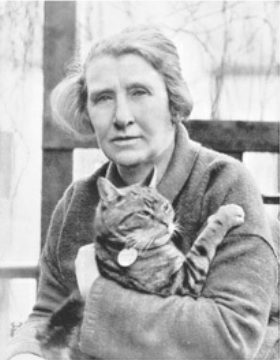 Cicely
Mary Hamilton (née Hammill, 15 June 1872 – 6 December 1952), was an English
actress, writer, journalist, suffragist and feminist, part of the struggle for
women's suffrage in the United Kingdom. Lesbian historian Liz Whitelaw's
dedica on
Cicely Hamilton (1990) is "In memory of
Rosemary Manning": one lesbian
biographer records another in a biography of a third. Feminists
such as
Margaret Haig, Cicely Hamilton,
or
Eleanor Rathbone and her
partner
Elizabeth Macadam decided to shy away from publicly identifying with
images portraying lesbians as pathological deviants and imitators of men.
Cicely Hamilton was a close friend of
Elizabeth Robins,
Helen Archdale,
Christopher St John (Christabel
Marshall),
Winifred Holtby,
Margaret Rhondda and Rebecca West.
Cicely
Mary Hamilton (née Hammill, 15 June 1872 – 6 December 1952), was an English
actress, writer, journalist, suffragist and feminist, part of the struggle for
women's suffrage in the United Kingdom. Lesbian historian Liz Whitelaw's
dedica on
Cicely Hamilton (1990) is "In memory of
Rosemary Manning": one lesbian
biographer records another in a biography of a third. Feminists
such as
Margaret Haig, Cicely Hamilton,
or
Eleanor Rathbone and her
partner
Elizabeth Macadam decided to shy away from publicly identifying with
images portraying lesbians as pathological deviants and imitators of men.
Cicely Hamilton was a close friend of
Elizabeth Robins,
Helen Archdale,
Christopher St John (Christabel
Marshall),
Winifred Holtby,
Margaret Rhondda and Rebecca West.
Cicely Hamilton herself lived entirely in a world of relationships with women, although discerning her closest intimacies is hard because, like other public women of the time, she left, probably deliberately, few traces of evidence – an uninformative autobiography, but no private papers or diaries and few letters. Her most intimate friend was probably Elizabeth Abbott, a married Scottish suffragist and a leading figure in a number of suffrage organizations. Cicely Hamilton, a powerful advocate of women’s rights and equality, and a later friend of Winifred Holtby’s, started out persuaded by her family that being attractive to the opposite sex was essential if she was not to be a failure. But as time passed and other activities left no space in her life for marriage, she relapsed gratefully into being an Aunt Jane – living alone with just her cat Peterkin for company, like a witch. No, it was not how she had envisaged her life turning out, but it suited her and she had no regrets.
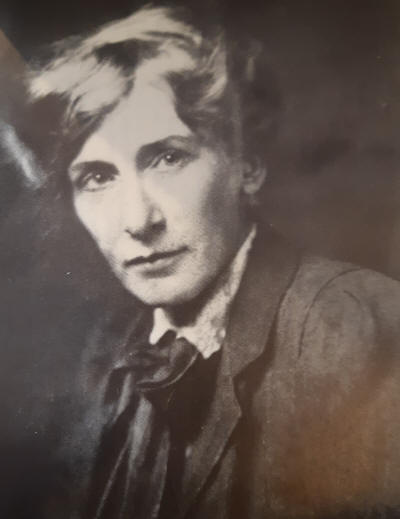
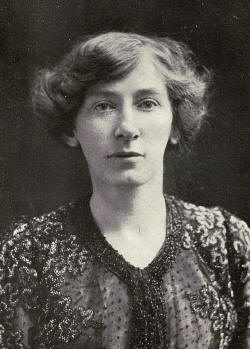
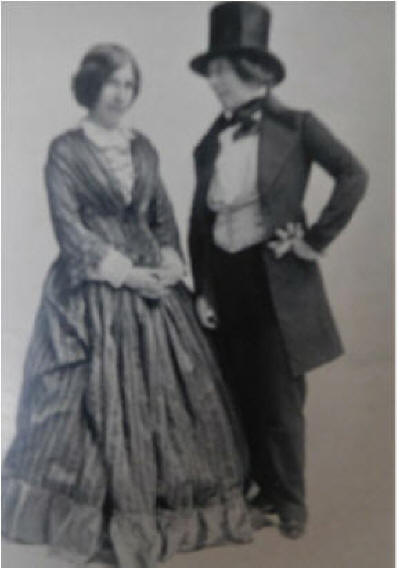
Cicely Hamilton and
Christopher St John as George Eliot and George Sand, c. 1911
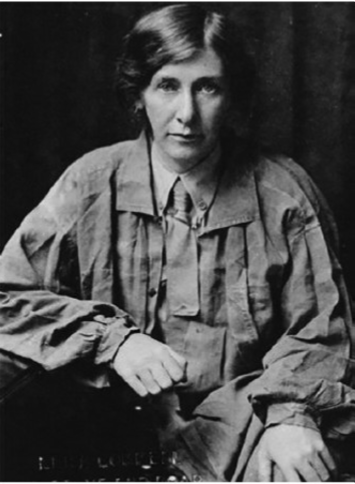
Cicely Hamilton lived with a cat called Peterkin, and she was clearsighted about Peterkin’s role in her life. She herself contributed greatly over the years. As a writer, campaigner for women’s rights, teacher and journalist, she was a committed and lifelong feminist. Early on she had come to recognise that frittering her life away trying to be attractive to the opposite sex was a waste of her valuable time, and that her ambitions would be unachievable with a husband in tow. Choosing not to marry was for her a cool-headed decision. Cicely was emphatically not uncomfortable about living alone, ‘…like the traditional spinster, with a cat for company’. In her sixties, after a busy life, she found solitude brought contentment. But the cat helped. Cicely was as absorbed by the qualities of her beloved Peterkin, with whom she poses on the frontispiece of her autobiography (Life Errant, 1935), as Elizabeth Goudge and Angela du Maurier were by their dogs. Cats, Cicely claimed, made better companions in a solitary household than dogs. Dogs were too apt to give ‘persistent, uncritical worship…’, whereas cats did not suffer fools. With a cat around, you didn’t need a human companion to tell you your faults. Though fond of her, Peterkin was, like all his species, selfish and lazy, and Cicely felt that his presence was a salutary rebuke to her own tendencies to moral turpitude. "With a cat there is no need of the human antidote; the cat is not given to worship. It is affectionate – that I can testify – but without any element of fawning; rather is it balefully authoritative. However humble its immediate ancestry, it remembers its divine descent; born in the gutter it will enter a drawing-room and take the best chair for itself!"
The British Society for the Study of Sex Psychology (BSSSP), of which Edith Lees Ellis was a member, was established in 1913 to provide a forum for the discussion of new ideas in the field of sex reform. The first woman member of the society was the militant suffragist Cicely Hamilton, and she was soon joined by a number of other notable feminists, such as Kathlyn Oliver and Stella Browne, and by Mrs Mary Scharlieb, one of the first women to gain a medical qualification in Britain. The membership of these women suggests that feminism and sexuology were not necessarily antithetical views and feminists did not reject the idea of sexologists such as Havelock Ellis and Edward Carpenter.
Cicely Hamilton’s own closest friends in the suffrage network were Edy (Edith) Craig and Christopher St John (Christabel Marshall), who lived together, and then later in another 30-year-long ménage à trois with Tony (Clare) Atwood, a painter of some distinction, a trio known to their friends as ‘Edy and the boys’. The adopted male names were accompanied by masculine dress: ‘Miss Craig,’ wrote Virginia Woolf in her diary, ‘is a rosy, ruddy “personage” in white waistcoat, with black bow tie & gold chain loosely knotted.’ Virginia Woolf’s own lover, Vita Sackville-West, with whom St John was besotted, described Edy Craig as ‘the most tearing old lesbian’. She compared her to Radclyffe Hall, one half of the most celebrated public lesbian couple of the 20th century, and a famous masculine dresser. Radclyffe Hall and her lover, Una Troubridge, were close friends of Edy and the boys, and of Cicely Hamilton. Troubridge, recalling her meeting with ‘John’, as Radclyffe Hall had been named by her first (female) lover, remembered the ‘rough country clothes; heavy short-skirted tweeds unusual in those days, collars and ties and … a queer little green Heath hat’. Troubridge herself was monocled and shingled and wore trousers. There is something very moving about the photograph opposite in Hamilton’s autobiography of her and Christopher St John dressed as George Eliot and George Sand, respectively, for a fancy-dress ball in 1911. The past, when recovered, is replete with demonstrations that claiming citizenship is so much easier if you pretend to be a man. Ethel Smyth, the feminist composer with whom Cicely Hamilton worked (she put words to Smyth’s suffragist melody March of the women, which Smyth is renowned for conducting with a toothbrush in Holloway prison), often wore men’s clothes and had multiple passionate attachments to women, including Emmeline Pankhurst and Virginia Woolf. Woolf, who was flattered by Smyth’s attention, called her a ‘valiant truculent old mosstrooper of a woman’; watching Smyth conduct her music with a pencil, with a drip at the end of her nose and knocking her hat from side to side, Woolf wondered if Smyth might actually be a great composer.
Hamilton is now best known for the feminist play How the Vote was Won, which sees a male anti-suffragist change his mind when the women in his life go on strike.[1][2] She is also credited as author of one of the most frequently performed suffrage plays, A Pageant of Great Women (1909), which featured the character of Jane Austen as one of its "Learned Women." [3]
Born Cicely Hammill in Paddington, London, she was the eldest of the four children of Maude Mary and Denzil Hammil. She was educated in Malvern, Worcestershire and in Bad Homburg vor der Höhe.[4]] Hammill was raised by foster parents because her mother had gone missing.[2] After a short spell in teaching she acted in a touring company. She took the pseudonym "Cicely Hamilton" out of consideration for her family. Then she wrote drama, including feminist themes, and enjoyed a period of success in the commercial theatre. Hamilton was praised for her acting in a performance of Fanny's First Play by George Bernard Shaw.[2]
In 1908 she and Bessie Hatton founded the Women Writers' Suffrage League. This grew to around 400 members, including Ivy Compton-Burnett, Sarah Grand, Violet Hunt, Marie Belloc Lowndes, Alice Meynell, Olive Schreiner, Evelyn Sharp, May Sinclair and Margaret L. Woods. It produced campaigning literature, written by Sinclair amongst others, and recruited many prominent male supporters.
Hamilton supplied the lyrics of "The March of the Women", the song which Ethel Smyth composed in 1910 for the Women's Social and Political Union.[5]
In the days before radio, one effective way to get a message out into society and to have it discussed was to produce short plays that could be performed around the country, and so suffrage drama was born. Elizabeth Robins's Votes for Women and Cicely Hamilton and Christopher St. John's How the Vote Was Won are two predominant examples of the genre.[6] Hamilton also wrote A Pageant of Great Women, a highly successful women's suffrage play based on the ideas of her friend, the theatre director Edith Craig. Hamilton played Woman while Craig played the painter Rosa Bonheur, one of the 50 or so great women in the play. It was produced all over the UK from 1909 until the First World War.[7] Hamilton was a member of Craig's theatre society, the Pioneer Players. Her play Jack and Jill and a Friend was one of the three plays in the Pioneer Players' first production in May 1911.[8]
During World War I Hamilton initially worked in the organisation of nursing care, and then joined the army as an auxiliary.[2] Later she formed a repertory company to entertain the troops. After the war, she wrote as a freelance journalist, particularly on birth control, and as a playwright for the Birmingham Repertory Company.[2] Hamilton was a regular contributor to Time and Time magazine, and an active member of the feminist Six Point Group.[2][9] In 1938 she was given a Civil List pension.
Hamilton's Theodore Savage (1922, vt. Lest Ye Die 1928) is a science-fiction novel about a Britain devastated by a war.[10]
Nina Boyle’s political and friendship network was far-reaching and on her death in 1943, a memorial fund was set up by her women colleagues specifically to keep alive the political issues that Nina Boyle fought for all her feminist career. The Nina Boyle Memorial Committee comprised Cicely Hamilton as chairwoman, Elsa Gye as honorary secretary and Marie Lawson, honorary treasurer. Members of Parliament who were also patrons to the Nina Boyle Memorial Fund included Eleanor Rathbone, Nancy Astor, Ellen Wilkinson, Irene Ward, Dr. Edith Summerskill and Megan Lloyd George. Cicely Hamilton who was a lesbian, first met Nina Boyle at one of Nina’s Suffrage speeches around 1910 and remained a lifelong friend until Nina’s death in 1943.
Cicely Hamilton and Edith Watson were Nina Boyle’s close friends. Cicely Hamilton, Winifred Holtby and Vera Brittain were at one stage neighbours of Nina Boyle. Margaret Haig, who later became Lady Rhondda, also knew Nina Boyle and became a Patron of the Nina Boyle Memorial Fund. Margaret Haig was also a very important friend of Cicely Hamilton, so much so that “she recorded her gratitude for it in her will”. According to Cicely Hamilton’s biographer, Liz Whitelaw, Margaret Haig lived for many years with Theodora Bosanquet, Henry James’ secretary, and the destruction of her personal papers on her death was to disguise that relationship.
On 16 June 1932, at the Dorchester Hotel on Park Lane, London, a number of British women writers and readers gathered for a Reception given by Time and Tide, the feminist weekly newspaper founded by Lady Margaret Rhondda in 1920. According to a report printed in The Times the next day, among those who had accepted invitations to be present were: Phyllis Bentley, Stella Benson, Vera Brittain, Professor Winifred Cullis, E.M. Delafield, Susan Ertz, Eleanor Farjeon, Cicely Hamilton, Winifred Holtby, Sylvia Lynd, Rose Macaulay, Naomi Mitchison, Edith Shackleton, Rebecca West and Ellen Wilkinson. Years later, Naomi Mitchison described Time and Tide as 'the first avowedly feminist literary journal with any class, in some ways ahead of its time', which in the early 1930s was 'in full flood, with a number of good authors writing for it'. Cicely Hamilton, stated in her autobiography that, 'Time and Tide [...] has meant more than a literary interest [...] it has given me friends'.
In July 2017, the Finborough Theatre staged the first London production of Hamilton's play 'Just to Get Married' in over 100 years. It received positive reviews (4 stars) from The Times [11] The Observer [12] The Evening Standard [13] and The New York Times [14]
My published books: